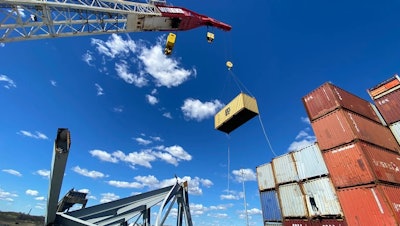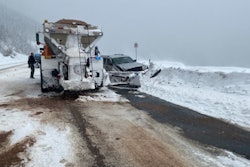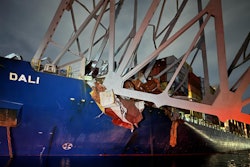
As crews begin to remove containers from the cargo ship and the remains of the I-695/Francis Scott Key Bridge the ship hit, the U.S. Army Corps of Engineers has released a timeline for cleaning up the underwater wreckage and reopening the Port of Baltimore.
According to the corps, an estimated 50,000 tons of steel and concrete are lying underwater – some of it sunken 4 to 5 feet in the muddy river bottom – equal to about 3,800 fully loaded dump trucks. Some of the debris has rested on top of the cargo ship Dali, where the crew has remained stuck since the bridge collapse March 26. The ship struck a pillar of the bridge, causing deck spans to immediately crash into the water around 1:30 a.m., killing six crew members working on the bridge fixing potholes. The body of a third crew member was found April 5, leaving three bodies still being searched for.
 Naval Sea System Command (NAVSEA) Supervisor of Salvage and Diving (SUPSALV), shows the wreckage resting at the bottom of the river where the Francis Scott Key Bridge once stood. The underwater sonar imaging tool, known as CODA Octopus, is the primary survey tool used by divers, with visibility clouded to just one to two feet because of the 4 to 5 feet of mud and loose bottom of the Patapsco River.Naval Sea System Command (NAVSEA) Supervisor of Salvage and Diving (SUPSALV)
Naval Sea System Command (NAVSEA) Supervisor of Salvage and Diving (SUPSALV), shows the wreckage resting at the bottom of the river where the Francis Scott Key Bridge once stood. The underwater sonar imaging tool, known as CODA Octopus, is the primary survey tool used by divers, with visibility clouded to just one to two feet because of the 4 to 5 feet of mud and loose bottom of the Patapsco River.Naval Sea System Command (NAVSEA) Supervisor of Salvage and Diving (SUPSALV)
A permanent reopened on the 700-foot-wide, 50-foot-deep channel is targeted for the end of May. That would restore the port to normal capacity, the corps says.
“These are ambitious timelines that may still be impacted by significant adverse weather conditions or changes in the complexity of the wreckage,” said Lt. Gen. Scott A. Spellmon, U.S. Army Corps of Engineers commanding general.
The difficulty of the salvage operation is compounded by the mirky waters of the Patapsco River. The corps likened it to “driving through a heavy snowfall at night with high-beam headlights on.” The divers are directed by voice command by operators using an underwater sonar imaging tool called CODA Octopus.
As for the cargo ship Dali, the Unified Command leading the collapse response began removing its containers Sunday. It is the next step in freeing the ship and removing it. Efforts to remove wreckage throughout the site will occur simultaneously, according to Unified Command.
Watch the video below of the container removal operation and see the graphic below that outlining the salvage operation and progress that has been made:
 The graphic above shows the salvage plan and progress made by Unified Command since the Francis Scott Key Bridge collapsed March 26.U.S. Army Corps of Engineers
The graphic above shows the salvage plan and progress made by Unified Command since the Francis Scott Key Bridge collapsed March 26.U.S. Army Corps of Engineers












